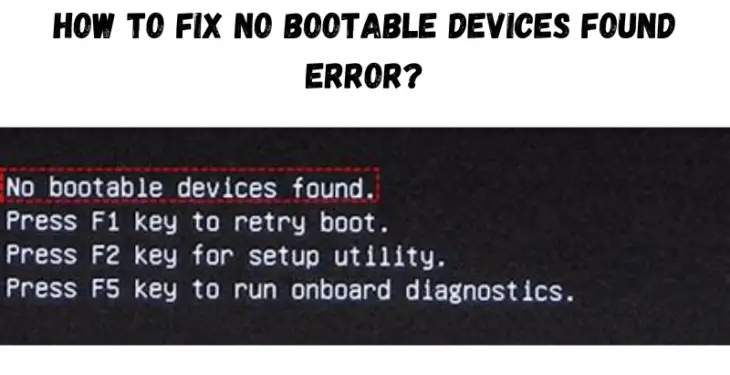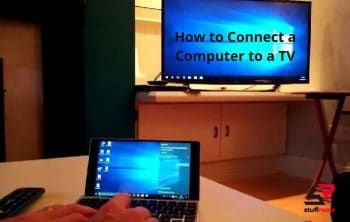In this article you will get to know how to fix no bootable devices found error. If you’ve started up your Windows PC and you’re faced with a “no bootable device” error, you might panic. While it could be a sign that your hard drive has failed, it could also point to a misconfigured boot order or corrupt system files, which can be fixed using certain Windows system commands like the System File Checker (SFC).
A “no bootable device” error can be problematic, but it can also be fixed by following some common troubleshooting steps. If you’re facing this error and you’re not sure how to fix it, the steps below should help you resolve the issue on Windows 10. A bootable device is a kind of storage hardware, such as hard drive, USB flash drive floppy disk drive, DVD, CD-ROM drive, which contains necessary boot files and drivers for loading the operating system.
BIOS is a program in computers used to load the operating system and execute the boot operation. The “no bootable device found” error is actually reported by BIOS. It means BIOS cannot find or locate the boot device or the boot files on the boot device are incorrect.
Read Article: Best Motherboard Among a320 vs b450?
What does “No Bootable Device Found on Windows 10″ mean?
This message means that your computer couldn’t find a healthy boot device. Bootable devices are the hardware that starts up your computer. This problem may occur if you have installed a new piece of hardware, such as a hard drive or CD-ROM drive, and Windows 10 can’t find the required files on it.
It can also happen if your system drive gets corrupted or damaged. While it isn’t always a serious issue, seeing the “No bootable device” error can certainly present problems. There are other messages you may see that mean the same thing as well. “No bootable devices found” is one. A bootable device is any piece of hardware that contains or can read the files required for a computer to start.
For example, hard drives, floppy disk drives, CD-ROM drives, DVD drives, and USB thumb drives are bootable devices. How do these devices affect Windows 10 and why are you getting these error messages? The no boot device found problem is essentially a problem of the BIOS.
BIOS contains the boot sequence which requires a bootable device to boot up or start the computer. This boot device is located on the PC itself, usually on the system partition. So when the BIOS can not detect the bootable device due to some error on the boot device, the no bootable device error pops up.
What causes the “No bootable device found” error on Windows 10?
There are multiple reasons why this error may occur on your device. Some of the reasons include:
- The boot order on your computer is incorrect.
- Your computer cannot identify the bootable device you have installed.
- Your bootable devices are damaged or corrupted.
- Your Windows 10 system partition isn’t active.
- There is a problem with your BIOS or CMOS settings.
- Your device’s boot disk MBR sector is damaged.
- An incorrect boot order- The partition in which the boot files are stored is not the primary booting device used by the BIOS.
- The system partition is not active.
- Internal hard disk is corrupted.
- The computer’s boot hard disk sector is damaged.
The “No bootable devices found” error is a pesky problem that many people deal with. After diagnosing the cause, it’s easier to take the necessary steps towards fixing this issue!
How to fix “No Bootable device found” on Windows 10
There are two main probable causes when you encounter this issue. These can be fixed with solutions which we detail below. You’ll also find general troubleshooting tips that may help you in restoring your device.
Method 1. Set your hard drive as the boot device.
Your hard drive may not be set as your first boot device in the BIOS. It should be the default unless you have specifically chosen to boot from a different device. Here’s how we can fix this issue:
- Restart the computer and tap Esc to enter the BIOS interface.
- Press the right arrow key on your keyboard until the Boot tab is opened. Move “Hard Drive” to the top of the boot order list by pressing “+” or “-”.
- Press F10 to save the changes and restart the computer.
Method 2. Remove and connect back all hardware components.
At first, you can completely power off your computer, remove all hardware devices, then put them back all properly. That can help check whether the BIOS did not detect the system hard drive due to lose connection and led to “no bootable device” issue. If this does not work for your situation, proceed to the next method.
Method 3. Fix corrupted MBR.
If the MBR (Master Boot Record) of your system drive gets corrupted, it can cause the “No boot device available” error in Windows 10. This is usually one of the main causes for this problem, and it can be fixed with a few easy steps. Here’s what you need to do to fix your device’s corrupt MBR:
- Insert the Windows installation media into your computer and boot.
- Select the language and region, and then click on “Repair your computer” when you see the “Install now” window.
- Select Troubleshoot and then Command Prompt on the Advanced options screen.
- In Command Prompt, input the following command lines and press Enter after each. (If you are asked whether you want to add a new installation to the boot list, type “Y” and then press Enter.)
- Exit Command Prompt and restart your computer.
Method 4. Launch Startup Repair
One of the first things you can do to repair the no bootable device found error is to use the startup repair. For this method, you’ll need a bootable Windows USB stick that contains the Windows Installation files.
Step 1:
First, we will have to change the boot order inside the BIOS to have a USB boot first. To do this enter the BIOS of your device. Ways to enter BIOS differ for each device, in most cases it is either Del, F12, or some other key. Use the keyboard to enter the boot tab. Here, changes the boot order, making the USB or disc containing the installation files to first.
Step 2:
Now restart your PC with the boot device and set up language, time, keyboard input method, and click next. Click the repair option present at the bottom left corner.
Step 3:
Now the scanning will begin and repair any issues that are found. If this doesn’t fix your boot issue, then move on to the next solution.
Method 5. Reconnect Hardware Components
If the no bootable devices found windows 10 error is occurring due to a loose connection or a severed wire, then this solution is the best bet. Disconnect all wires and hardware from the device and reconnect each one ensuring that there are no loose or faulty connections.
Method 6: Check Boot Order
BIOS shifting your hard drive down the boot order may cause the boot up error. In this method, you just have to ensure that the hard drive is first on the boot order, here’s how.
Step 1:
Enter BIOS by pressing the relevant key (F12, DEL, etc) after the restart.
Step 2:
Go into the boot tab using right arrow keys and push your hard drive up to the first position on boot order.
Method 7: Set Primary Partition as Active
If your system partition or the C drive has been inactivated by mistake, it can result in the no bootable devices found dell error. Follow these steps to make the C drive active again for a successful boot.
Step 1:
Insert the bootable Windows 10 USB stick or disc into your PC. Launch the installation and setup date, time, and keyboard input method.
Step 2:
On the next screen, click on repair your computer. Now select the Troubleshoot option and then click on Command prompt.
Step 3:
Write the following in the command prompt and click enter.
- lit disk
- select disk 0
- list partition
- select partition 1
- active
Method 8. Run CHKDSK to Check Errors
One of the probable causes of the boot device not found hp error is a defective internal disk. In these conditions, you can use CHKDSK to check for any problems. To do it, follow the above solution up to the point of opening the command prompt. Once you’ve done that type in ‘chkdsk c: /f /x /r’ and executive. The CHKDSK will now scan for possible errors.
Method 9. Fix Boot Information Using Command Prompt
In addition to the above-mentioned fixes, the command prompt can also be used to fix boot information. Bring up the command prompt in the exact same as the above two methods and enter these command lines.
Method 10. Troubleshoot RAID issues!
If you are facing the no boot issue on a Dell laptop, then there are built-in diagnostic tools available that give you detailed reports of your RAID issue. Here’s how you can run those diagnostics.
Step 1:
Press the F12 key on the Dell splash screen on startup.
Step 2:
Choose Diagnostics from the menu and run it. In the report, you’ll be able to see the exact cause of the problem.
Note:
If you can boot into windows you can run the online Support Assist diagnostic test to aid in the dell support assist no bootable devices found error.
Method 11. Replace Hard Drive and Reinstall System
If nothing works for the boot device not found hp error, then it’s time to face the hard truth. You will have to replace system components like the hard drive and reinstall Windows.
Final words.
As for how to fix no bootable device in Dell, Acer, HP and other computers with Windows 11/10/8/7 installed, these 6 methods are reported to be effective. I sincerely hope you will get a proper method according to your special situation. Apart from the above functions, AOMEI Partition Assistant also comes with many other great features: migrate OS to SSD, clone hard disk to another hard disk, extend system drive without reboot, etc.






